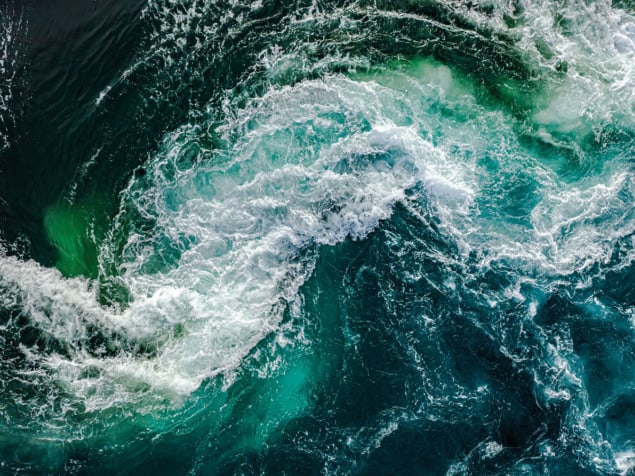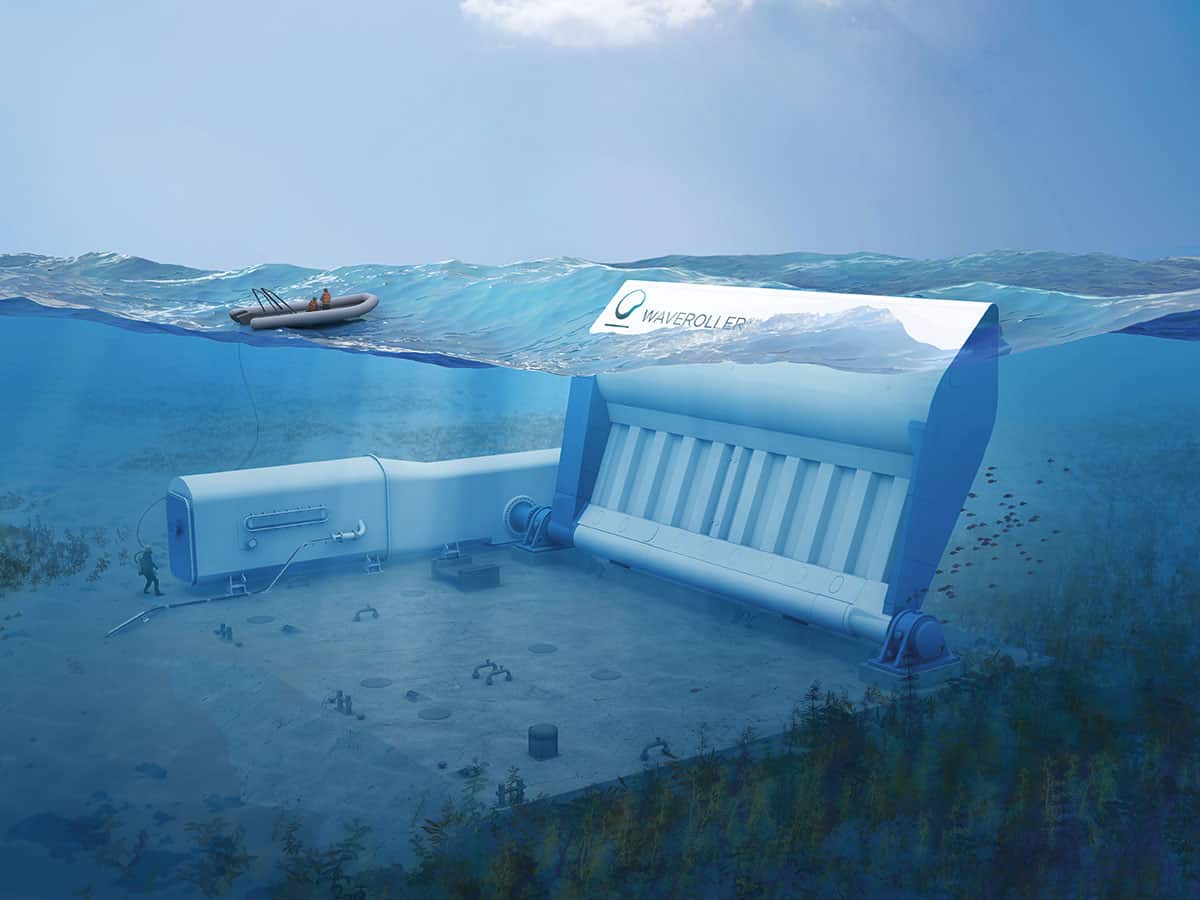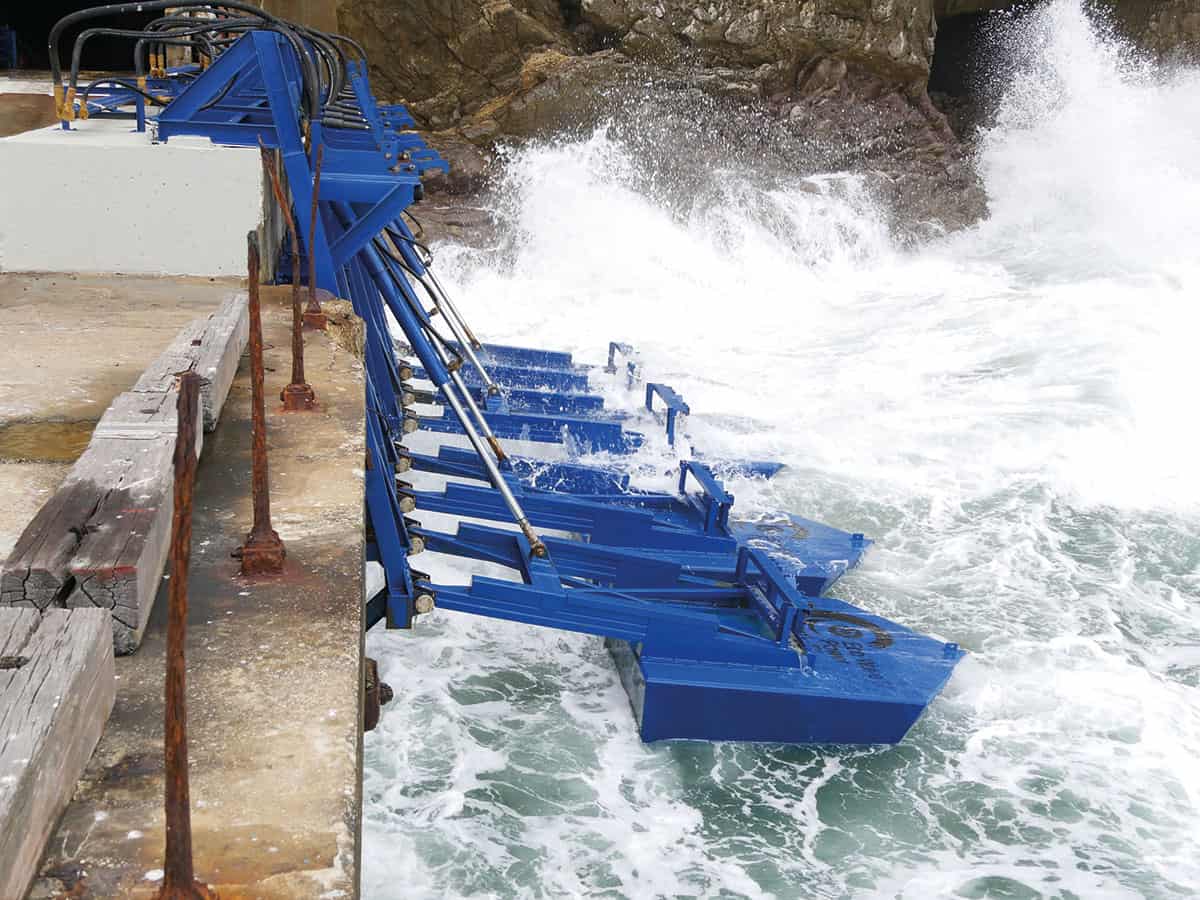Huge technical and financial hurdles face anyone seeking to harness the vast power of the world’s oceans. For a devout band of researchers and hi-tech business pioneers, however, the dream of “blue energy” lives on, as Stephen Ornes discovers

In many ways, the ocean seems like the most obvious place in the world to look for energy.
Water covers about 70% of the planet, and much of it, driven by the Sun, is in constant motion. Surface swells ferry energy from one place to another, while tides and currents, as reliable as the sunrise, move vast volumes of water in very short times. The ocean is essentially a natural engine, converting solar energy into mechanical energy. Hardly surprising, then, that for at least 200 years, visionaries have dreamt of harnessing that constant, reliable motion and using it to power the world.
Numerous proposals have been made in this quest for “blue energy”, ranging from the practical to the outlandish. Perhaps the first known patent was filed in 1799 by a French family who wanted to use a lever – with one end bouncing on ocean waves – to power their sawmill and other machines. Since then, from the straits off northern Scotland to the wind-swept shelf waters near Victoria and Tasmania in Australia, scientists have been searching for the ocean’s “sweet spots”, where energy harvesting is feasible, reliable and cheap.
Harbours, tidal rivers and coastlines around the world have become testbeds for systems that can generate power, plug into the grid and survive the harsh conditions of the sea. Indeed, a study published in Science in May 2019 (364 548) further sweetens the pot. After analysing data from satellites and a global network of floating buoys, ocean engineer Ian Young and mathematician Agustinus Ribal, both from the University of Melbourne in Australia, found that the ocean’s tallest waves are getting taller and that ocean wind speeds are increasing – likely because of climate change. They could therefore have more energy to share.
But at least two variables threaten to submerge these efforts. The first is money. Between 2013 and 2015, at least three big companies with plans to connect wave-power generators to the electricity grid all lost funding and abandoned their projects. One of them, Pelamis, had tested facilities around the world. Another, Aquamarine, based in northern Scotland, had spent 10 years developing a floating-buoy wave-generator system, called the Oyster, but failed to bring in investors. A third, Oceanlinx, began in Australia in 1997 and was sold to a Hong Kong company in 2014.
The sea is an unforgiving environment. It is corrosive, fouling, energetic and forceful
The other big hurdle is the power of the sea itself. In the winter of 1988, for example, a fierce storm in Toftestallen, Norway, slammed a wave-power plant that had been installed barely three years earlier. The unhinged tower collapsed and the station had to be rebuilt, only to be destroyed again by accident during an attempted improvement three years later. In 2009, meanwhile, a dozen underwater turbine blades were wrecked by strong tides in the Bay of Fundy, Canada, less than a month after they had been plumbed in. And in November 2007 a brand new power-generating test buoy that had cost $2m to install took on too much water and sank in the Pacific waters off the coast of Oregon.
“The sea is an unforgiving environment,” admits Elaine Buck, a technical manager at the European Marine Energy Centre (EMEC), an open-sea testing facility based in Stromness, Orkney, Scotland, that studies wave- and tidal-power generators. “It is corrosive, fouling, energetic and forceful. Marine energy is harnessed at the extreme environmental edges.” Hardly surprising, then, that ocean power has made far fewer inroads than other sustainable-energy sources, such as solar and wind.
Ups and downs
There are, though, signs of progress. To see one in action, you can go to Gibraltar, the British territory that juts out from Spain into the Mediterranean Sea. On the east side of The Rock, on a jetty used during the Second World War to transport ammunition, lie eight blue mechanical arms attached to wide buoys that rise and fall as waves roll in from the sea. When waves reach a height of 0.5 m, the device’s oscillating arms drive pistons that pump hydraulic fluid into an onshore power station. There, the fluid spins a hydro motor, generating electricity that flows into Gibraltar’s grid.
Installed in 2016 by Eco Wave Power – a Swedish firm based in Tel Aviv, Israel – the wave station currently has a capacity of 100 kW of electricity. That should be enough to power a few dozen homes and makes Gibraltar one of the few places in the world where ocean waves supply the electrical grid. Eco Wave Power now intends to scale up the technology by installing more units to provide 5 MW of electricity, which would represent 10–15% of the territory’s demands. The firm is also planning future projects where wave power has potential, including in Portugal, Italy, the Netherlands, Australia, Mexico and the UK. The sum total of all these proposed projects would be 190 MW, says Eco Wave Power’s chief executive, Inna Braverman.

Another firm in the blue-energy game is the Finnish company AW-Energy, which last year installed a device called a WaveRoller on an off-shore platform near Peniche, a seaside village in Portugal. It’s a rectangular panel that, unlike the machine in Gibraltar, is anchored to the seabed and oscillates back and forth as waves pass. That action sends hydraulic fluid through a set of sealed pipes, driving a hydraulic motor that generates electricity. The company is currently collecting off-grid test data on the machine.
Perhaps the longest-running blue-energy project is in the Bay of Biscay, off the coast of northern Spain. Completed in 2011, it consists of a set of 16 columns drilled into a 440 m-long artificial breakwater that juts into the sea from the town of Mutriku. Ocean waves push air through the columns, with the resulting high air pressure spinning turbines. Developed by the Scottish firm Wavegen, the facility is owned by the Spanish utility company Ente Vasco de la Energia. It has so far supplied 1.6 GWh of electricity to the local grid – roughly the same as you’d get from burning 650 tonnes of coal.

Biomass energy: green or dirty?
Despite these inroads, however, wave energy isn’t remotely close to a tipping point where it’s both commercially appealing and sustainable on large scales. “Wave energy development has yet to move past prototype-scale projects, funded by government grants, private investors, and venture capital,” concluded an analysis published by Bloomberg Finance in September 2019.
Too big to fail
According to the US Energy Information Administration, the world will use more than 21,000 TWh of electricity overall in 2020, with roughly three-quarters of that consumption coming from China and the US. Global usage is estimated to rise by 50% over the next 30 years. However, more than four-fifths of the world’s energy currently comes from burning non-renewable fossil fuels such as coal and oil, which release gases into the atmosphere and affect climate change.
Turning to the seas for an energy seems a no-brainer. The ocean is an energy-rich environment, which makes it an appealing alternative to fossil fuels. The Sun heats the land and air, and – as warm air rises and cool air rushes in beneath – winds blow and push the water. Waves rise and race as gravity works to restore equilibrium. The rate at which waves deliver energy (the energy flux) depends on how fast the waves are moving and on the “significant wave height” – a variable that oceanographers use to characterize how high the highest waves tower over sea level. (The energy flux also depends on the density of the water, though that’s treated as a constant for ocean waves.)
The power delivered by tides depends on the volume and speed of water passing a particular point. According to the US Ocean Energy Council, an average coast-pummelling wave towering 1.5 m over the sea’s surface delivers about 16 kW per kilometre of coastline. Meanwhile, a 2017 analysis by the International Energy Agency reckons that the amount of energy stored in waves, worldwide, is about 80,000 TWh, of which about 4000 TWh could be harvested and converted into electricity. More conservative estimates, such as those from the UK-based Carbon Trust, suggest a harvestable range of 2000–4000 TWh.

The promise and challenges of airborne wind energy
Ocean currents – rather than waves or tides – are similarly appealing. In 2017 Tsumoru Shintake – an engineer at the Okinawa Institute of Science and Technology Graduate University in Japan – claimed that if energy harvesters could harness the current moving along just 1% of the Japanese seashore, you’d generate more power than from 10 nuclear plants. Scientists at the Coastal Studies Research Institute in North Carolina calculated that capturing just 0.1% of the power in the Gulf Stream, which runs along the east coast of the US, would yield 300 GW – equivalent to more than 150 nuclear plants.
In light of the fact that half of the world population lives within 80 km of a coast, these figures suggest the ocean could, in the future, provide up to 10% of the world’s energy demands. That doesn’t include the energy gained from harnessing tides, which some researchers say has the potential to be even more efficient – and stable – than wave-energy products. So if scientists can find the right approach, then the entire energy demand of the world – or a significant part of it, anyway – could be met by the ocean. But that’s a colossal if.
Sunken dreams
Perhaps the most ambitious blue-energy project – the likes of which the world has never seen – was the brainchild of a German engineer named Herman Sörgel (1885–1952). Dubbed Atlantropa, he described it in a 1929 book and spent his life trying to convince others to get on board. Essentially, Sörgel wanted to build hydroelectric dams around the Mediterranean Sea, including a huge one across the Strait of Gibraltar, which would lower the sea level and connect Europe to Africa through new, usable land masses. A dam across the Congo River, meanwhile, would irrigate the Sahara Desert and produce fertile new plains.
Sörgel’s attempt to harness the ocean never saw the light of day. Nor did many others, despite appearing feasible, at least on paper. Take the Bay of Fundy, which lies between the islands of New Brunswick and Nova Scotia in Canada. Apart from being home to a dizzying variety of whale species, the bay boasts the world’s highest tides, which can reach more than 15 m in height. That fact led one enterprising engineer from Boston to persuade the US government in the 1930s to give him $7m to build machines to harvest the bay’s tidal energy. A plant was built and a small town grew around it, but in 1936 funding ran out and the project was declared too expensive. The town evaporated.
Since then, a steady stream of proposals have washed in and out, like the tides themselves. In 2009, for example, a collaboration between Scottish and Canadian companies built an underwater turbine in the Bay of Fundy, but it was destroyed by powerful tides less than a month after installation. Between November 2016 and April 2017, the same collaborators – working under the name Cape Sharp Tidal – tried again, this time with a grid-connected turbine in the bay’s Minas Passage. But with the firm plagued by technological and financial problems, last April the government of Nova Scotia ordered the turbine to be removed. Undeterred, another firm – Jupiter Hydro from Alberta – has recently obtained two permits to test new turbines in the water.
Beneath the waves
Back at EMEC in Orkney, Buck says many projects have come and gone since the centre was set up in 2003. Indeed, experience has taught her not to try to predict what unknown challenges lay in the future, with Buck joking that “it’s about as realistic as determining the outcomes of Brexit”. In the last two years, for example, EMEC has hosted a grid-connected, floating tidal-power generator, built by a Scottish company called Orbital, that generated 3 kWh in 2018. An upgraded version of the same device has a planned installation for later this year. There have also been some unexpected failures, like an inflatable, floating wave-power harvester that sank to the seabed in March 2019. (It will be recovered later this year.)
Buck says, however, that she’s not daunted by the fact that many projects don’t pan out. “There are successes and failures,” she says, “but learning is in the failures.” And the more projects they test, she says, the shorter the learning curve for future developers with big ideas.
Ultimately, Buck says, she sees the most promise in those devices that can harness the tides as opposed to those powered by waves. “Technological challenges for wave power still remain,” she says, but “tidal [devices] are on pace to deliver grid-scale power.”
Most approaches to harvesting mechanical energy from ocean waves rely on finding a way to move a conducting wire through a magnetic field to generate electricity. It seems the obvious way of going about things, given that electromagnetic generation is the cornerstone of the entire power-generation industry. From fossil-fuel plants to wind turbines, the basic conversion from mechanical energy to electricity is the same.

But ocean harvesters don’t have to work that way, argues Zhong Lin Wang, an engineer at the Georgia Institute of Technology, in Atlanta. Over the last few years, he has been building triboelectric nanogenerators, or TENGs, which he says could revolutionize energy harvesting. Instead of generating power using moving conductors and magnets, Wang’s TENGs generate a trickle of current using static electricity. In these devices, two materials rub against each other – one donating charges, the other collecting them – and the accumulated charges flow through an attached wire. Wang has used TENGs to design, among other things, keyboards that harvest energy from typing, and table-tennis tables that can record a ball’s trajectory and speed, powered by the bounce of the ball itself.
“These could become a very important energy source,” he says. Wang has, for example, designed TENGs in small plastic spheres, about the size of oranges, that float in water. As the waves jostle the sphere, material inside bumps against the outer shell, generating charges. Those charges then flow through an attached wire. In lab tests – and in night-time experiments conducted at his neighbourhood pool – each one can generate about 10 mW of power.
That’s not much, Wang admits, but he thinks it could be used at first for powering small devices – think sensors on buoys used to collect data on the sea. Moreover, he thinks the technology will scale up. “Imagine we make a network, like a fishing net,” says Wang, who envisages a grid of spheres, each about 10 cm apart, and extending 10 m down into the water. Such a configuration, but scaled up to the size of the state of Georgia (about 400 km wide and long), could power the whole world, he believes.
Wang’s approach offers appealing advantages. Basic physics says that the energy carried by a wave is proportional to the square of its height, as well as the square of the angular frequency. Electromagnetic generators – like those used in most wave-harvesting devices – therefore work best at high frequencies. But Wang’s TENGs follow the rules of electrostatic generators, which means that their output scales linearly with frequency. So while conventional wave harvesters have an advantage for giant swells, TENGs can function even with small vibrations. Rivers, which typically don’t have a strong enough current for wave harvesters, might therefore be good testing grounds for TENGs.

TENGs could also have an advantage in big storms, which pose problems for conventional wave-harvesting. Eco Wave Power’s device in Gibraltar, for example, has to raise its mechanical arms out of the water when big tempests roll in. But a TENG, because of its flexible design, should be able to take a beating. “It works the best with the worst weather conditions,” says Wang.
But if TENGs can withstand the sea, Wang doesn’t have a solution to the financial problems that torpedoed projects in the Bay of Fundy, the islands of Scotland, and other initiatives that seemed promising at first. “People ask me, can you demonstrate it?” he asks. “I say, no, I don’t have funding for that.”
And ultimately, it’s not the swells of the ocean that remains the most formidable challenge; it’s the finite finances of would-be sponsors. So even if physicists and engineers can tame the sea, they’ll have to persuade funding bosses, business executives and the public that it’s worth pumping money into harvesting energy from the Earth’s waters. “For wave and tidal machines to be perfected through testing and demonstration,” says Buck, “the sector requires full support from government and society alike.”



